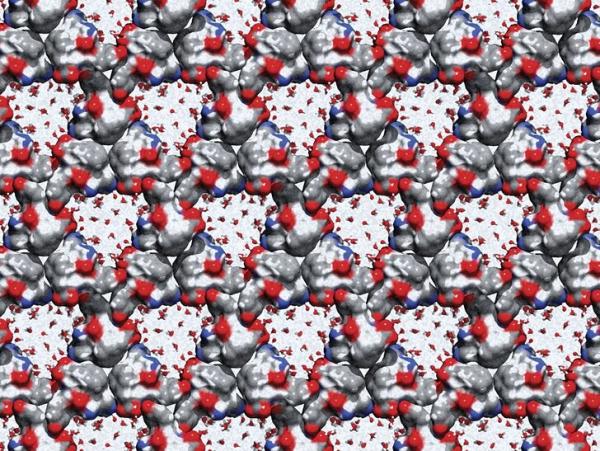
A tripeptide crystal with aqueous pores can reversibly deform in response to humidity changes. Image courtesy: Tong Wang.
Imagine harnessing evaporation as a source of energy or developing next generation actuators and artificial muscles for a broad array of applications. These are the new possibilities with the creation by an international team of researchers, led by The City College of New York’s Xi Chen and his co-authors at the CUNY Advanced Science Research Center, of shape-changing crystals that enable energy transfer from evaporation to mechanical motion. Entitled: “Mechanistic insights of evaporation-induced actuation in supramolecular crystals,” the study appears in the journal “Nature Materials.”
Different from traditional crystals that are usually stiff and brittle, the new crystals have the ability to change their shapes, enabled by their molecular architectures. The crystals are comprised of a pattern of small pores that is interspersed with connecting flexible domains that are repeated throughout the crystal structure. The pores that run throughout the crystals strongly bind to water molecules.
“When evaporation causes water to be removed from the pores, this results in a forceful deformation of the entire crystal through a network-like connection. The resulting shape-change is reversed when water vapor is reintroduced,” said Chen, the corresponding author of the research and an assistant professor, chemical engineering, in CCNY’s Grove School of Engineering. “Our peptide crystals allow the direct observation of water-material interactions at the molecular level by using existing crystallographic, spectroscopic and computational methods. The revealed actuation mechanisms are applicable more generally for the deigns of materials or structures that efficiently harness evaporation.”
Materials that drive these motions are known as water-responsive or humidity-responsive materials. These materials, that swell and contract in response to changes in humidity, could directly and efficiently convert energy from evaporation into mechanical motions. This new field opens up possibilities for accessing untapped water evaporation as a source of energy as well as developing better actuators and artificial muscles for modern engineering systems.
The research was co-led by Rein V. Ulijn of Hunter College and the Advanced Science Research Center at the Graduate Center, CUNY; and Tell Tuttle of University of Strathclyde, Scotland. Researchers from CUNY, University of Strathclyde, and New York University were also involved in the research.
Support was provided by the Office of Naval Research through the Biomaterials and Bionanotechnology program, the Air Force Office of Scientific Research, the National Science Foundation, and the United Kingdom’s Engineering and Physical Sciences Research Council.
About the City College of New York
Since 1847, The City College of New York has provided a high-quality and affordable education to generations of New Yorkers in a wide variety of disciplines. CCNY embraces its position at the forefront of social change. It is ranked #1 by the Harvard-based Opportunity Insights out of 369 selective public colleges in the United States on the overall mobility index. This measure reflects both access and outcomes, representing the likelihood that a student at CCNY can move up two or more income quintiles. In addition, the Center for World University Rankings places CCNY in the top 1.8% of universities worldwide in terms of academic excellence. Labor analytics firm Emsi puts at $1.9 billion CCNY’s annual economic impact on the regional economy (5 boroughs and 5 adjacent counties) and quantifies the “for dollar” return on investment to students, taxpayers and society. At City College, more than 16,000 students pursue undergraduate and graduate degrees in eight schools and divisions, driven by significant funded research, creativity and scholarship. CCNY is as diverse, dynamic and visionary as New York City itself. View CCNY Media Kit.